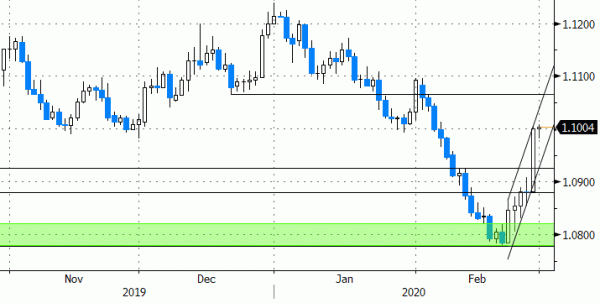- Rates: Hemorrhage on markets
Financial markets are pricing a scenario where the coronavirus pushes a late cycle economy in a global recession. This week’s stock market losses exceed 10% with US rates currently discounting three Fed rate cuts in 2020, possibly starting in March. There is no reason yet to fight the trends despite overbought (bonds) / oversold (stocks) conditions. - Currencies: EUR/USD caps 1.09 and is flirting with 1.10
Corona driven panic caused another bloodbath on markets yesterday. The selling wave continues unabatedly during Asian trading hours. Core bond yields extend recent declines, keeping the dollar in a soft spot going into the weekend. EUR/USD is flirting with 1.10. We expect the pound to remain in the defensive as BoJo revived the no-deal threat.
The Sunrise Headlines
- WS continued its bloodbath as recession angst dragged all 3 major indexes lower. The Nasdaq underperformed (-4.61%). The sell-off in Asian markets extends as investors flock to safe havens. Japan underperforms (-4.26%)
- OPEC and its allies are showing a “renewed commitment” to reach an accord to stabilize the oil market, Bloomberg reported. Saudi Arabia wants the group to agree to collective production cuts of an additional 1mln b/d, FT reported.
- Japan’s jobless rate jumped to 2.4% from 2.2% in January. Retail sales picked up by 0.6% (M/M) from 0.2%. (Core) inflation in February was weaker than anticipated (0.5% vs. 0.6%) amid subdued demand and lower energy prices.
- ECB president Lagarde disclosed the central bank is closely watching the coronavirus epidemic but led a chorus of ECB officials by downplaying the need for immediate monetary-policy response.
- Spain’s parliament approved new spending ceilings, a first important step towards approving a new budget. Sanchez’s left-wing government was only able to secure a majority thanks to the abstention of Catalan separatists (ERC).
- South Korea is closely monitoring markets, in particular sell-off activity of foreigners’ South Korea stocks. The country pledged it will take strict measures if one-sided moves in FX markets increase on speculative bets.
- Today’s economic calendar contains inflation numbers in the US, Germany, France and Italy. Q4/2019 GDP prints will be published in Canada and Sweden. Speeches from the Fed’s Bullard and the BoE’s Haldane and Cunliffe are due
Currencies: EUR/USD Caps 1.09 And Is Flirting With 1.10
EUR/USD caps 1.09 and is flirting with 1.10
Another massacre unfolded on financial markets yesterday. Corona driven panic pushed Wall Street more than 4% lower and thereby into correction mode (at least -10%) at the fastest pace on record. Needless to say that stronger than expected data on both sides of the Atlantic went unnoticed. Core bond yields collapsed again, significantly more so in the US than in Germany. Just as we’ve seen in the past few days, that supported EUR/USD despite outright risk-off. The pair rose more than a big figure, closing at 1.10 (up from 1.088). Lagarde said the ECB is monitoring the virus but ruled out a response at the current stage. The yen gained; USD/JPY weakened from 110.43 to 109.59.
The bloodbath continues in Asia this morning as investors fear the consequences of corona on the economy. South Korea underperforms losing up to 4%. Japan slips about -3.5% as the yen extends its safe haven gains. USD/JPY declines below 109 (108.86). The kiwi dollar slips toward 0.624 amid the first report of a corona case, eying the 2019 and multiyear low of 0.62. A rate cut is now almost fully priced in by May. The Aussie dollar weakens in lockstep to 0.652, the lowest level since the GFC. EUR/USD is holding near yesterday’s close around 1.10 with the dollar remaining in a soft spot.
We would have had a semi interesting economic calendar (PCE inflation, German and French CPI, several ECB and Fed speeches) were it not for the coronavirus to hijack all market attention. Despite US yields printing new record lows, this morning’s price action suggests there is no halt in the decline yet. That might continue to cap a dollar recovery in the short run. We hold our cautious dollar bias going into the weekend. Although the euro isn’t particularly shining either, the EUR/USD balance (of weakness) is probably still tilted in favour of the common currency. We find additional comfort in the technical charts after EUR/USD pierced through intermediate resistance (now support) at around 1.0950.
UK PM Johnson put forward a tight timetable for the Brexit negotiations and put a no-deal scenario back on the table if there is no significant process made for a Canadian-style agreement by June. EUR/GBP jumped to 0.853 (from 0.843). EUR/GBP might keep the ST upward bias from the previous days as next week’s trade talks come into focus
EUR/USD regains 1.09, moving further away from the 1.0778 support














